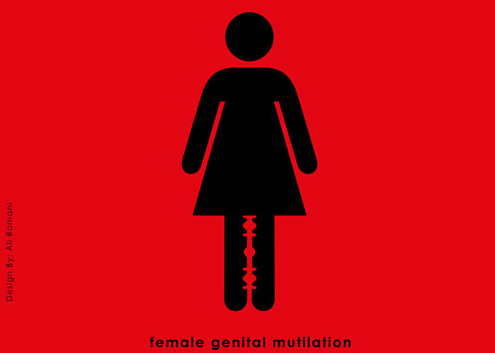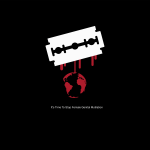
The psychologist Karl Albrecht places fear of mutilation second in a hierarchy of five basic fears from which all other fears devolve. The only greater fear, he claims, is that of extinction. Below mutilation, there is the fear of loss of autonomy—being paralyzed, entrapped, imprisoned. Then fear of separation—abandonment and rejection. Then there is fear of ego death—humiliation and shame. Short of death, then, mutilation is our most primitive fear. The fear of genital mutilation is—universally, across time and cultures—the most acute fear of all. As David Wood reported for the Huffington Post,
Before they went off to fight in Afghanistan, the guys of 3rd Battalion, 5th Marines talked quietly about their deepest fear. Not dying. Not losing a leg or an arm.
It was having their genitals ripped off, burned away or crushed in the fiery blast of an improvised explosive device.
The ritual excision of some or all of the external female genitalia, typically with a blade, knives, razors, scissors, glass, or sharpened rocks, is a crime against women that is almost always committed by other women. The nature of the mutilation varies by country and ethnic group, ranging from amputation of the clitoris to the removal of the inner and outer labia and the sewing shut of the vulva, leaving a small hole for the passage of urine and menstrual fluid. In cultures where the practice is prevalent, women view the genitals as sources of shame, dishonor, and impurity. They fear that if their daughters and granddaughters are not mutilated, they will be stigmatized and socially outcast.
The sexual mutilation of girls is a crime with no parallel in cruelty. Saying so in forthright language, however, seems to be beyond us. International organizations largely focus in their literature on the medical consequences of mutilation—“difficulty in passing urine, recurrent urinary tract infection, pelvic infection, infertility, keloid scar, abscess, cysts and abscesses on the vulva, clitoral neuroma, difficulties in menstrual flow, calculus formation in the vagina, vesico-vaginal fistula (VVF), recto-vaginal fistula (RVF), problems in child birth, failure to heal”—as if this catalogue of misery were the gravamen of the case. It is not. The gravamen is the assault on the human soul. Yet perhaps precisely because the practice is too horrible to contemplate, NGOs committed to eradicating it struggle to raise funds.
According to UNICEF, at least 200 million girls and women, in 30 countries, have been mutilated. Many researchers fear this is an underestimate: In some countries, no reliable data exist, not least because large studies cannot be conducted without the host state’s cooperation. The practice is concentrated in a contiguous belt of countries in Africa, from Somalia in the east to Senegal in the west, from Egypt in the north to Tanzania in the south, with the highest prevalence in Somalia (98 percent), Guinea (97 percent), Djibouti (93 percent), and Egypt (91 percent). Reports of mutilation have surfaced in countries as far away from this belt as Colombia and Peru. In recent years, it has been discovered among immigrants to Europe and North America. It is more prevalent in Asia than researchers had initially realized, particularly in Indonesia.
While the origin of the practice is pre-Islamic (some evidence suggests it began under the Meroitic empire, in what is now Sudan, between 800 BCE and 350 CE), it is clearly reinforced by the obsessive preoccupations with chastity and virginity that characterize modern Islamic and Arab cultures. But it is neither practiced exclusively by Muslims—in regions where the practice is widespread, it is also common among Christians, animists, and Jews—nor do all Muslims practice it. It is almost unknown, for example, in Arab North Africa, Egypt apart; the prevalence in Iraq is confined to a handful of northern regions. Fortunately for those who seek its eradication, there is in fact no mention of it in the Quran. In 2007, the Al-Azhar Supreme Council of Islamic Research in Cairo ruled firmly that sexual mutilation has “no basis in core Islamic law or any of its partial provisions” and is a sinful practice. It is nonetheless widely believed among Muslims in affected regions to be a religious obligation. Campaigners against the mutilation of girls in Iraqi Kurdistan enlisted the cooperation of local religious authorities, which was easier to secure than one might expect: There, as everywhere, it is women who organize the practice and insist upon it for their daughters. It seems to be easier to persuade men against it.
The evidence from Iraqi Kurdistan suggests grounds for cautious optimism. There, a determined campaign to eradicate genital mutilation—heavily focused on television ads—has made a great deal of difference, quickly. The work of international NGOs has been critical to this campaign, as has concerted international pressure. This is why Western attitudes matter, why media reports in the West matter, and why the language we use to describe the problem matters. Westerners fund these campaigns. If we are uninformed about the prevalence of the practice or the utility of campaigns to stamp it out, we will be less likely fund the kinds of campaigns that work. Thus the media’s failure accurately to tell this story to Western publics is tragically negligent.
In recent years, for example, the West has been fed a nonsensical story about Kurdish women, one suggested by these headlines: “The feminist transformation in radical Kurdistan,” “The Kurdish woman building a feminist democracy and fighting Isis at the same time,” “Modern feminism: why we should learn from Kurdish women,” “The Kurdish feminists fighting Islamic State,” “Female Kurd soldiers fighting ISIS explain why they wear lipstick and make-up on battlefield,” “For the woman warriors of Iraqi Kurdistan makeup is essential equipment.” Readers must understand that these headlines are the product of a branding exercise. Female fighters represent less than one percent of the Kurdish Peshmerga forces. We are drowning in comely photos of Kurdish women adorned in lipstick and camouflage gear because Kurdish men want the West to back their cause—or causes, as the case may be—militarily and diplomatically.
In reality, a 2010 study conducted by the reliable German-based NGO WADI found that 72.7 percent of girls and women in the Kurdish Autonomous Region of northern Iraq—save for the Dohuk Governorate—had been mutilated. Honor killings by male family members and forced marriage remain commonplace throughout Kurdish society. As WADI recently described Iraqi Kurdistan,
Many women do not have the faintest idea of the meaning of women’s rights. In their society, men have rights and women have duties. Traditional notions of honor and shame rule all aspects of life. Violence against women is perceived as part of the natural order of things. Children are not seen as individuals, but more treated as property. Obedience and submission are the main virtues.
If Western feminists have anything to learn from Kurdish women, it is that they should get down on their knees and thank God they were born in the West.
There is no hope of changing a reality with which we refuse to be in contact. Western pressure, Western NGOs, and Western money have, in fact, been critical to reducing the rate of mutilation in Iraqi Kurdistan. But Westerners who fondly imagine Kurds to be building in the region a radical-Kurdish-porn-feminist-democracy are useless to all concerned. Reporters who relay these fairy tales to gullible publics do measurable harm to real women and real girls because public attitudes dictate public policy and spending priorities. Our priority should be to spend more money on television ads that discourage sexual mutilation: In the real world, such ads are needed—and such ads seem to work.
The reduction in the rate of mutilation in Iraqi Kurdistan is genuinely encouraging, even if it is hard to be sure how significant it really is. The reasons for the reduction are several-fold. First, as a consequence of the Iraq War, Iraqi Kurdistan was flooded with international NGOs providing medical assistance and social services. WADI, in particular, was able to collect evidence of the practice that local authorities could not deny. A wide range of international human rights organizations then put massive pressure on the Kurdistan Regional Government and the Kurdistan parliament to take steps to enact laws against it. The pressure resulted in the issuance of a fatwa from the High Committee for Issuing Fatwas at the Kurdistan Islamic Scholars Union—the highest Muslim religious authority in Iraqi Kurdistan—stating that the practice had no Islamic basis and discouraging parents from mutilating their daughters. For geopolitical reasons, officials in Iraqi Kurdistan were unusually vulnerable to foreign pressure, and NGOs on the ground skilfully seized the moment.
In early 2007, WADI created a network of local women’s organizations and initiatives dedicated to raising public awareness of the health consequences of the practice. They placed ads in major newspapers calling for a ban. They used television commercials, brochures, films, and information centers to warn of the practice’s health consequences. As their 2010 report acknowledges, the campaign was unquestionably successful in conveying the message that sexual mutilation is gravely harmful. They were encouraged, they wrote, to see that “the message of FGM-awareness is getting through.” However, they noted,
The answers show us that we can no longer expect frank admissions when asking about the intention to mutilate. The same can probably be said as well for our question about daughters who have died as a consequence of FGM. Contradicting all experience on the ground, none of the women in our survey admitted to having had to mourn one of their children as a result of the practice. The appearance of such false statements is clearly bad news for future surveys.
There are nonetheless reasonable grounds to believe the practice is in decline. A recent study conducted by the Heartland Alliance in cooperation with UNICEF and the High Council of Women Affairs showed a stunning decline in reported rates of mutilation:
Most noticeable are the declines in Erbil, Suleymania and Halabja, where FGM rates were previously much higher than in the province of Dohuk. While 60.3% of mothers reported to be cut in Suleymania, they reported this about their daughter only in 11.8% of the cases. In Halabja, the practice seems to be almost eradicated. While 40% of mothers said they had undergone the procedure, only 1.1% of their daughters had done so.
This either represents a dramatic decline in the practice or a dramatic growth in the realization that the practice is criminal and should not be discussed with foreign researchers. Even if it is the latter, it’s a step in the right direction.
The survey data suggest that one form of intervention is, overwhelmingly, more effective than all the others: television ads. Among respondents who had heard that genital mutilation was harmful, 88.4 percent had heard it on television. Given high rates of female illiteracy in the region, this is unsurprising. More surprising is that, by comparison, only half of the respondents had heard there was a law against it. Moreover, the influence of social workers, health workers, mobile units, and teachers seems to have been negligible. Television ads appear to have been so much more effective than other means of persuasion—and so surprisingly effective, full stop—that campaigners against sexual mutilation should consider redirecting the bulk of their funding to television ad buys:
By far, the largest percentage of respondents report being exposed to stop-FGM/C campaigns through television (88.4%), compared to only 4.5% through newspapers, and 6.0% through radio. Leaflets, brochures, billboards, and posters were indicated by less than 4.0% of respondents as the source of the FGM/C eradication messages. Stop-FGM/C messages were also spread among families and social networks, with friends and neighbors reported as sources at 14.7%, and family and relatives at 13.4%. Among civil society institutions, NGOs were the most cited source of anti-FGM/C messages at 9.4%. TBAs, health or social workers, mobile units, and teachers were reported by less than 3.0% of all respondents.
The evidence suggests that under propitious political circumstances, and with enough television advertising, social attitudes about mutilation can change quickly. Given this, there is no excuse for fatalism. Working with local NGOs, the West should publicly and privately fund as many such ads as possible in every region of the world that may be affected. It is an urgently important moral cause.


